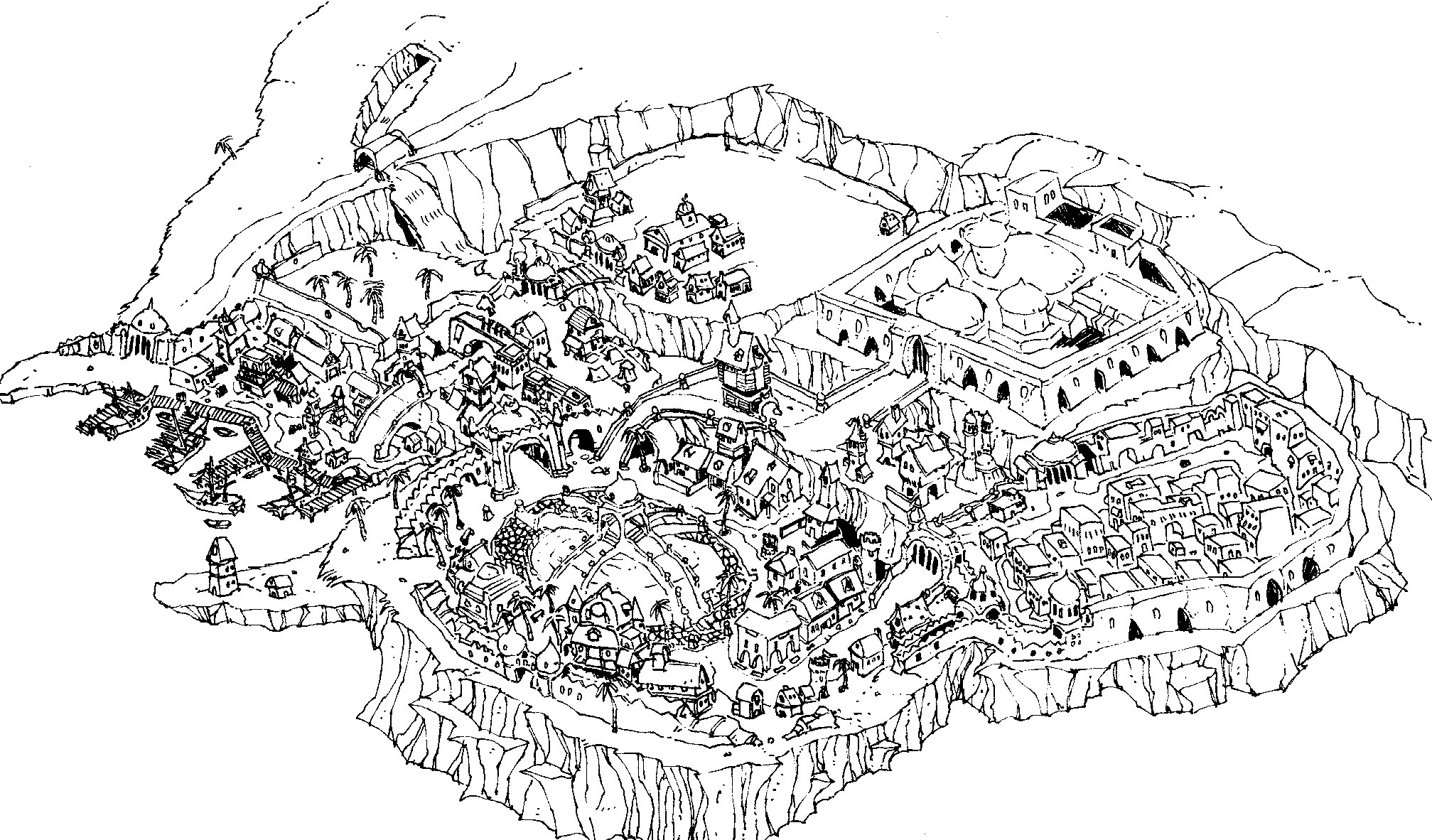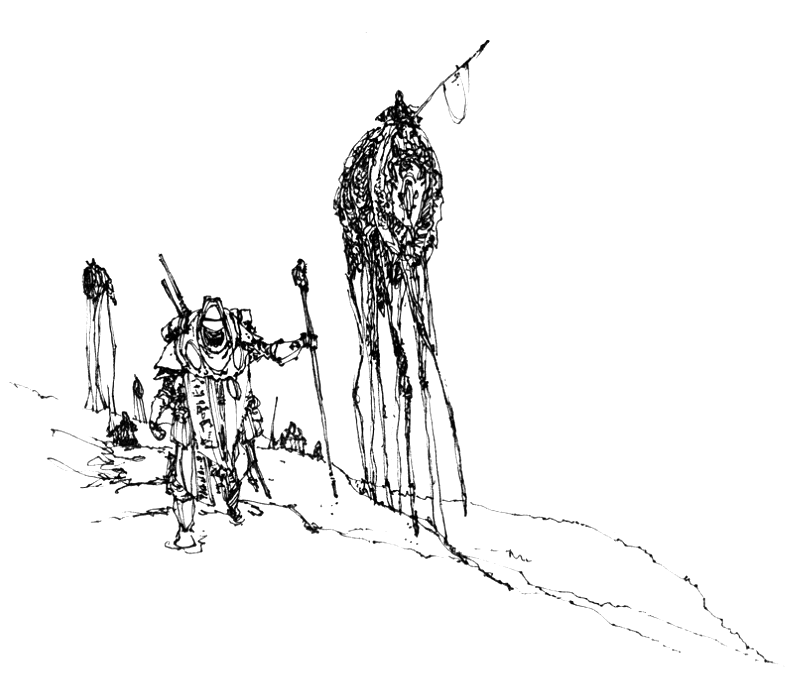SUNDUSK
Lore
Geography of Sundusk
The realm of Sundusk is surrounded on all sides by a great mountain range known by many names,
but most broadly as the Duskrim. Within the Duskrim is the vast basin of the Ashlands.
Civilization is almost entirely relegated to the edges of this desert, and most folk live in
one of the Rim Cities in the foothills. Beyond this is the inhospitable Dune Sea, inhabited
only by the Ashdrow nomads. At the center of the Ashlands are two volcanic peaks called the
Searing Sisters, whose eruption devastated this land long, long ago, and at the foot of these
are the Glasslands, known to the Ashdrow as "Get In and You'll Never Get Out."
The Duskrim opens only twice: once to the west in a narrow and dangerous mountain pass called
the Gash, and again to the south-west by way of a wide tableland. Both of these offer passage
to the sprawling jungles of Soulspear beyond. Across the mountains to the north and the east
is only the sea.
The Duskrim
Colloquially just "the Rim." The outlanders of Soulspear call them the Ashkeepers, and
revere them as the only barrier standing between the lush jungles and devastating ash.
The Rimfolk know them as the Corona Range, or the Coronas, and often depict them in maps
as rays of sunlight ringing the dismal Ash Wastes. The Ashdrow name for them means Arena.
The mountains are immense and brutal, and only the fiercest monsters and harshest of
folk call them home, including orcs, goblins and giants. In the west, the orcish tribes
have been united under one chieftain, who rules from the city of Orkhorum, overlooking
the Gash.
The Rim Cities

There are nine major cities spread more or less evenly around the Rim. These city-states
have been united within kingdoms and empires of ages past, but are most often independent
and in varying degrees of enmity, rivalry and alliance. The Rim Cities include Seydaneen,
Sarrakeen, Tatooeen, Ruun and Barsuum.
The Table
The Table is a vast steppe which spans or interrupts the Duskrim in the south-west.
Resting above the Dune Sea, the land here is less arid and more lively, though still
quite barren. Seydaneen and Sarrakeen rest in the foothills at opposite ends of the
Table, and their competing claims to this territory have been the source of many
conflicts across the ages.
The Table is the homeland of the Diba, hyenafolk nomads dedicated to hunting and
destroying the Gnolls which roam the steppe. The Table is also populated by Thri-kreen.
The Myth of Sun-Dusk
Long ago, the Children of Lloth lived in great kingdoms of their own making. But war came
and the kingdoms fell, and the Drow became fugitives in their own lands. When they needed her
most, the Lady Lloth came to her children and rescued them from the Underdark. She guided them
through the perils of the Duskrim and led them unto the Valley of the Dawn.
Yet as they neared the Valley, they were stopped by the mighty Ra Hoor, who was the companion
of Soth. Lloth commanded Ra Hoor to go in peace, but when he refused, it is true that she
slaid him. Having done so, the guided her Children into the Valley that they may build their
kingdoms again.
When the Lightbearer discovered the death of Ra Hoor, he became furious. He came to Lloth on
the twin peaks which survey all of the Valley and demanded his revenge. There the siblings did
battle and the fate of Lloth was sealed. But truly no victory could quell the fury of Soth, so
great was his love for Ra Hoor. He turned his ire upon the Children of Lloth and the Valley
which she had promised them, devastating it in light and fire and ash.
Having done this, Soth returned to the body of Ra Hoor and cast a brilliant and fiery light
upon it. He fashioned it onto his spear and thrust it into the heavens, so that all may see
the glory of Ra Hoor and remember what was done to him. And the Drow were made to feel the
light as punishment for the actions of their Lady.
And so great is the arm of mighty Soth that the Soul of Ra Hoor crosses all of the heavens
before descending into the Netherworld. And every night, Ra Hoor must journey through the
world of the Dead to be reunited with the Lightbearer. And every dawn, the Soul-Spear is
thrust again into the sky.
And the people of Sundusk remember.
The Death of Lloth
Many in the world believe that Lloth was merely defeated and banished from the World Above,
but survives as the god of darkness, locked in a perpetual struggle with Soth, observed as
the cycle of night and day. The people of Sundusk, however, know that Lloth was slain and is
a dead god, unable to defend the realm from Soth's eternal fury.
After slaying Lloth, Soth took up her body and tore it to pieces, scattering it across the
realm. In this way, Lloth was truly and utterly destroyed, and none could give her a new life
in the world—as he had given Ra Hoor by creating the Sun. According to the Rimfolk,
wherever Lloth's remains landed, there her people were born. And so, with the death of Lloth,
the Drow were born not as one people but many.
The Ash-Dawn Prophecy
The Ashdrow nomads do not believe in such parables. As the true descendants of the
Children of Lloth who fled the Underdark, the Ashdrow believe that Lloth shall be
resurrected, and will free her people of Soth's fury and return Sundusk to the Valley
that was promised them. This is known as the Ash-Dawn Prophecy.
In accordance with the prophecy, the Ashdrow belief is the inverse of that commonly held
by Drow in the Rim Cities. The Rimdrow have forgotten their purpose, which is to restore
the body of Lloth that it may be resurrected. Thus, the Ashdrow have divided into many
tribes, each wandering the Dune Sea in search of Lloth's sundered corpse. While not all
Ashdrow dedicate their lives to fulfilling this prophecy, most tribes believe it is true.
The Heart of Lloth
The most essential piece to the Ash-Dawn Prophecy is the Heart of Lloth, without which even
the most complete body cannot be resurrected. The people of Sundusk (whether or not they
believe in the prophecy) believe that Sil, the third twin of Soth and Lloth, recovered her
Heart and interred it deep within the volcanoes at the center of the Ashlands.
It cannot be known what the trickster god intended by doing this. Some believe it was done
out of sympathy, protecting the Heart from those who would destroy it. Others believe it was
done in malevolence, positioning the Heart in the one place the Drow could never hope to
reach. The Ashdrow view it as a test, for only a people willing to brave the Glasslands and
descend into a volcano are worthy of possessing the Heart of Lloth.
The Ashdrow
The Ashdrow are a diaspora of dark elves who live in Sundusk. While "Ashdrow" generally refers
to the nomadic drow of the Dune Sea—also known as the Ashlanders—many of their
descendants have settled in the Rim—sometimes called "Rimdrow" to distinguish them from
the nomads—and a few have left Sundusk entirely. All of these folk share a common ancestry,
as the descendants of exiles fleeing persecution in the Underdark, and most believe in the
Sun-Dusk myth as the shared story of their origin.

The Ashdrow nomads are mysterious to the people of the Rim, who consider the Dune Sea to be
uninhabitable. How they survive and live is not well understood, although it is known that they
rely on a deep understanding of Ashland ecology. Nomadic clans occasionally come to the cities
to trade. While Ashdrow wares are admired and sought after, their most essential and valuable
commodity is ash-salt, a mysterious substance of rare magical properties that is found only in
the Dune Sea, and thus purveyed almost solely by the nomads.
As they have moved in and out of the Ashlands over time, leaving and rejoining their clans over
generations, the Ashdrow have mingled with other races. As a result, even the most reclusive of
clans consist of folk of diverse features and skin colors, ranging from shades of grey to deep
browns and indigos to nearly jet black. Some Ashdrow clans even include individuals who are not
drow or even elven. Ashdrow hair is typically light, and their eyes are often a vibrant red, the
effect of generations of a diet rich with ash-salt.

